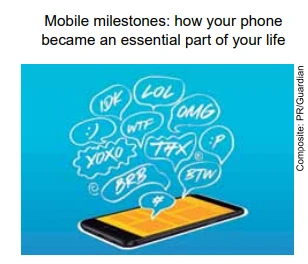Disciplina: Inglês 0 Curtidas
No trecho do quarto parágrafo “and even these filled - UNIFESP 2018

Has any device changed our lives as much, and as quickly, as the mobile phone? There are people today for whom the world of address books, street atlases and phone boxes seems very far away, lost in the mists of time. Following, there are just some of the big milestones from the past 30 years that have made almost everything we do easier, more public and very, very fast.
• The first phones arrive – and become status symbols Few people got the chance to use the very early mobile phones. The first call was made in New York in 1973, but handsets with a network to use were not available until 1983 in the US, and 1985 in the UK. That first British mobile phone was essentially a heavy briefcase with a receiver attached by a wire. It cost £2,000 (£5,000 in today’s prices), and gave you half an hour’s chat on an overnight charge. Making a call was not something you could do subtly, but that wasn’t the point; the first handsets were there to be seen. They sent a message that you were bold and confident with new technology, that you were busy and important enough to need a mobile phone, and were rich enough to buy one.
• Text messages spawn a whole new language The first mobiles worked with analogue signals and could only make phone calls, but the digital ones that followed in the early 1990s could send SMS messages as well. After the first message was sent on 3 December 1992, texting took off like a rocket, even though it was still a pretty cumbersome procedure. Handsets with predictive text would make things easier, but in the 1990s you could save a lot of time by removing all excess letters from a message, often the vowels, and so txtspk ws brn. Today the average mobile phone sends more than 100 texts per month.
• Phones turn us all into photographers... There seemed to be no good reason for the first camera phones, which began to appear in 2002, with resolutions of about 0.3 megapixels. They took grainy, blurry pictures on postage stamp-sized screens, and even these filled the phone’s memory in no time. Gradually, though, as the quality improved, the uses followed. As well as the usual photos of friends and family, they were handy for “saving” pieces of paper, and in pubs you could take a picture of the specials board and take it back to your table. Modern camera phones have changed beyond recognition in the past 20 years. The new mobile phones boast the highest resolution dual camera on a smartphone: a 16-megapixel camera and a 20-megapixel camera side-by-side. The dual camera allows users to focus on their subjects, while blurring out the background, producing professional-looking portraits.
…and we turn ourselves into celebrities
Twenty years ago people would have thought you a little strange if you took flattering photos of yourself and your lifestyle and then distributed them to your friends – let alone to members of the public. If you used printed photographs rather than a smartphone app, they would still think so today. Yet sharing our lives on social media is now the norm, not the exception – and it was the camera phone that made it all possible. Now, some phones come with an enormous 64GB of memory, so you can capture, share and store an almost countless number of videos and pictures – well, certainly enough to keep up with the Kardashians.
(www.theguardian.com, 07.07.2017. Adaptado.)
No trecho do quarto parágrafo “and even these filled the phone’s memory”, o termo em destaque se refere a
-
grainy, blurry pictures.
-
postage stamp-sized screens.
-
phone’s memory.
-
camera phones.
-
resolutions of about 0.3 megapixels.
Solução
Alternativa Correta: A) grainy, blurry pictures.
A alternativa correta é a a) "grainy, blurry pictures" porque o contexto da frase menciona que as primeiras câmeras de celular produziam "grainy, blurry pictures" (fotos granuladas e borradas) e, em seguida, afirma que "even these filled the phone's memory in no time." O uso da palavra "these" se refere diretamente às fotos de baixa qualidade mencionadas anteriormente, indicando que, mesmo com sua qualidade insatisfatória, elas rapidamente ocupavam a memória do telefone.
O parágrafo detalha a evolução dos celulares com câmera, começando pela qualidade pobre das imagens geradas. Essa explicação sugere que, apesar das limitações tecnológicas dos primeiros modelos (como baixa resolução e imagens de qualidade ruim), esses dispositivos ainda tinham um uso prático e tornavam-se populares. A menção ao preenchimento da memória do telefone reforça a ideia de que as fotos, mesmo sendo de qualidade inferior, eram rapidamente armazenadas, indicando o aumento da quantidade de imagens tiradas.
As outras alternativas não são corretas, pois se referem a conceitos que não estão diretamente ligados à frase em questão. A alternativa b) ("postage stamp-sized screens") menciona a tela, mas não se refere a "these" que é usado para se referir às fotos. A alternativa c) ("phone's memory") é uma parte da frase que descreve o que estava sendo preenchido, mas não é o que "even these" refere-se. A alternativa d) ("camera phones") é uma referência ao tipo de dispositivo, enquanto a alternativa e) ("resolutions of about 0.3 megapixels") fala sobre a qualidade da câmera, não das fotos. Portanto, apenas a alternativa a se encaixa na referência feita na frase.
Institução: UNIFESP
Ano da Prova: 2018
Assuntos: Interpretação Textual em Inglês
Vídeo Sugerido: YouTube